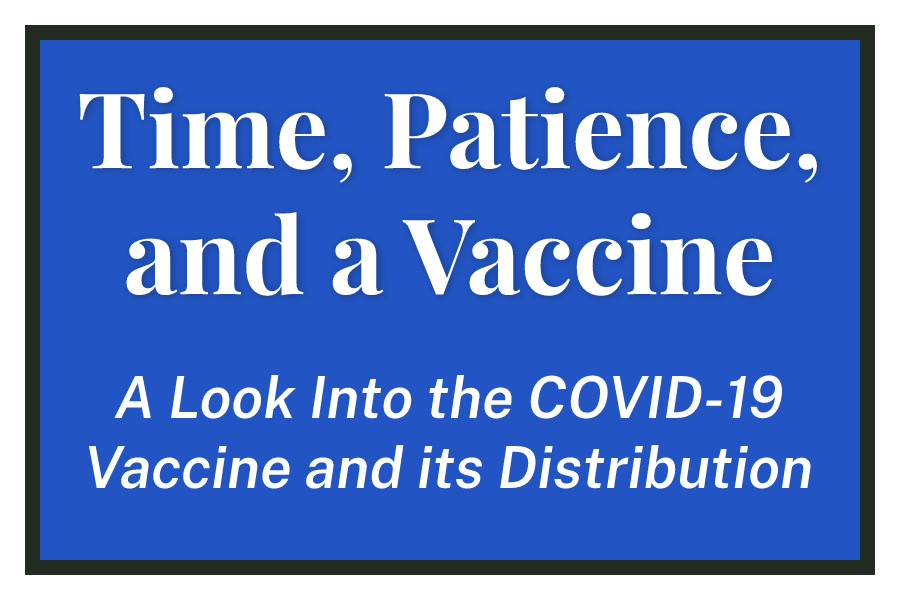Time, Patience, and a Vaccine
A Look Into the COVID-19 Vaccine and its Distribution
While everyday Americans were moving into lockdown and attempting to stay safe, scientists were testing and beginning to develop vaccines for COVID-19. This started as soon as the first wave of the coronavirus swept through the United States. After nine months of work, on December 11, the Pfizer coronavirus vaccine was given emergency use authorization from the FDA. Only four days later, the Moderna vaccine was also FDA authorized. Within 24 hours of the approval, both vaccines were being packed and distributed to Americans. Most states will follow the CDC recommended distribution list, starting with healthcare workers who are at high risk of exposure to the coronavirus as Phase One.
In Phase Two of distribution, people with chronic medical conditions will be vaccinated, and around March of 2021 the vaccination will get distributed to the rest of the U.S population. America is working toward herd immunity, where enough people in the population have developed long lasting immunity from the virus. As the vaccination continues to be distributed, case numbers for the coronavirus should begin to lower as people become less at risk.
Upper School Biology teacher Bridget Lesinski has been doing research and reading on the Pfizer vaccine and its distribution. “From what I have seen, I can’t see many large flaws in distribution or where it is starting,” Lesinski said. “It is hard with the two shot Pfizer vaccine for scheduling purposes, but I read the first shot still gives you a good boost of immunity, and hopefully people will be on top of their second appointment.”
The Pfizer and Moderna vaccines are the first MRNA vaccines in history. Although the vaccines are new technology and new to humans in general, Lesinski doesn’t see that as a problem because immunologist Dr. Anthony Fauci and other scientists have been studying this type of vaccine for around 15 years.
Anne Nelson, Parker’s school nurse, got the Pfizer first shot of the vaccine on January 1, 2020, and plans to get her second on January 23 2021. “Getting to the location of where my shot was was far, but the overall process went well,” Nelson said. “I scheduled it one day before I was able to get it, but when I checked again, everything was booked.”
Dr. Ritu Garg, an internal medicine doctor at Loyola University of Chicago, recently received the Pfizer Vaccination and understands the distribution of the vaccine. “Overall I think the distribution of the Pfizer vaccine is very difficult because of the temperature setting on negative 17 degrees, but one flaw of the vaccination is the side effects which you encounter after you get your first part of the vaccination,” Garg said of the Moderna vaccination and distribution. “Moderna vaccination has the benefit of having a better temperature setting than the Pfizer vaccination, so to this the vaccination will get distributed faster, and now since we have two vaccinations, more people could be possibly vaccinated,” Garg said.
Nelson believes the only flaw is the distribution line. “I think getting it from the federal to the states was fine,” Nelson said. “But the problem is, we need a federal response, because the state government is different in each state.” Nelson explains how some states are doing better than others, and a federal response would make the distribution work better and get out faster, especially considering that we have most vaccines, but less than a fraction of it is actually being properly utilized.
“I spoke with a friend who works from home, and she recently got her vaccination scheduled for April,” Lesinski said. “That gives an interesting timeline for the future and when things will begin to feel normal again.” Even with the vaccine distribution, Lesinski wonders what school could look like as only 18+ students can receive the Moderna vaccine and only 16+ with Pfizer. Dr. Garg believes getting the vaccination distributed will take a decent amount of time, saying it would be difficult, as people don’t know how long the immunity of this vaccination will last, and it will take a whole year to finally get back to normal.
Some people are concerned about taking this vaccination. “Many people have fear as to how this vaccination was developed in such a short period of time, but these companies have worked hard on this vaccination module, and this vaccination is specifically designed for a pandemic,” Garg said. Nelson hopes people don’t rely too much on the first shot. “The shot won’t bring max immunity, although it will lessen the possibility,” Nelson said. “Still, America is struggling because of impatience, and three weeks is quite a while to wait for some Americans.”
Lesinski, Garg, and Nelson all expressed hope that this vaccine will bring the world back to normal, but know it will take time and patience. Nelson sees hope for June, July, or August, but still does not see activities like school being normal. Most Americans see hope for this vaccine, but all will take time.








